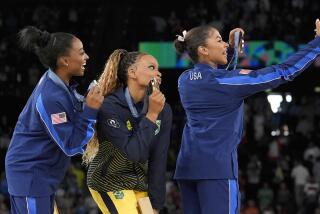DOWN DUSTY PATHS : Holly Farr Chases Olympic Dream
- Share via
DULZURA — Making the mental connection between biathlon, a sport with roots in Scandinavian hunting techniques, and Dulzura, a quiet town set among the brush and scrub oaks of southeastern San Diego County, is not easy.
Holly Farr is the connection. She is using the summer biathlon as a stepping stone for a comeback in the winter version.
Farr, 32, will be among those competing in the West Coast Championship of Summer Biathlon at the South Bay Rod and Gun Club in Dulzura at 8 a.m. today. The event combines running and shooting, rather than the winter biathlon’s cross-country skiing and shooting.
Farr, a member of the bronze medal winning U.S. women’s biathlon relay team at the 1984 World Championships, will continue her comeback from frozen lungs she suffered while competing in a winter biathlon in 1985.
Farr’s problems started at the tryouts for the U.S. team in 1985. The tryouts were supposed to be held on the East Coast, but they were moved to Quebec for better snow conditions.
Overexertion in sub-zero weather with high humidity caused Farr to suffer from frozen lungs. And she was forced to push herself because balky ammunition was causing her to fall steadily behind.
“I couldn’t find any ammo that would shoot,” Farr said. “I had to take a bore brush and put the ammo in at each stop. I got mad and I tried to make up for (it) with my skiing. When it’s that cold, you have to cut back.”
She didn’t discover the damage to her lungs until later, when she tried to work out.
“I was wheezing all the time and at first I thought it was pollen,” Farr said.
After some tests it was discovered that Farr had indeed suffered frozen lungs.
“That was the beginning of the crumble,” Farr said. “I was going through some personal things--family things. But things happen. You have to figure your luck is going to change.”
Farr is working her way back, trying to get into shape. She competed in the women’s National Biathlon Championships last year, but finished out of the top 10.
“I could be discouraged,” Farr said. “I wanted to find out where I was now that I’m not in my best shape.”
She is currently running track at MiraCosta Community College, where she also ran cross country last year. Farr divides her time between San Diego and Lake Tahoe, where she works on her skiing.
Originally, in fact, she aspired to be an alpine skier.
“(The coaches) told me I was basically over the hill in my early 20s,” said Farr. “And I was just getting good at it.”
While working at the Olympic center in Squaw Valley, Farr was introduced to biathlon.
“I went along with the (men’s team) for an event and a guy hands me a rifle and said, ‘Look, there’s an extra rifle, why don’t you race?’ ” Farr said. “I missed the first five and then I hit four of the next five and I got hooked.”
She was starting to get hooked at about the time women were starting to get involved in winter biathlon.
Though biathlon has been an Olympic sport for men since 1960, the first major international competition for women wasn’t until the 1984 world championships. The sport will be added for women at the 1992 Winter Olympics in France.
That hooked Farr again and got her thinking of a comeback after two years away from competition.
“The Olympics is a big carrot,” Farr said. “I love being an athlete and I discovered it too late in life. But I don’t think age matters that much. The important thing is being healthy.
“I look at this as my last chance. I feel like I tumbled and went out on a low note. I’d like to go out on a higher note. I want to come back and prove to myself, if nobody else, that I can do it.”
And so she is in Dulzura today, doing a different sort of biathlon.
In the summer version, competitors make two stops to shoot at five knock-down targets. The summer targets are about the size of a softball and are set at 25 meters, as opposed to the winter’s smaller targets set at 50 meters.
“We want people to hit them,” said Farr. “Most people are beginners who try this. We don’t want to make it too hard.”
The purpose of the summer biathlon, which started in earnest last year with a six-city tour, is to a acquaint people with a traditionally winterized sport. This year, the National Shooting Sports Foundation and the U.S. Biathlon Assn. are sponsoring a 10-city tour culminating with the national championships in October in St. Louis. San Diego is the second stop.
Of course Farr, who recently won the first summer event in Phoenix, has a reason for being in this dusty community today: She is trying to find winter.
More to Read
Go beyond the scoreboard
Get the latest on L.A.'s teams in the daily Sports Report newsletter.
You may occasionally receive promotional content from the Los Angeles Times.






